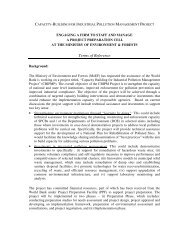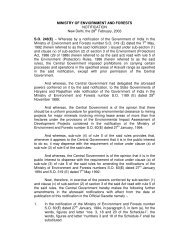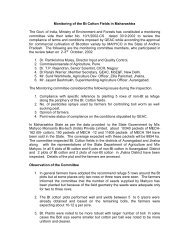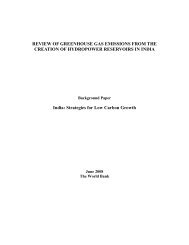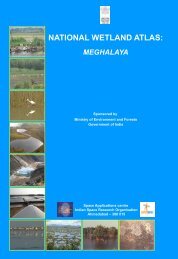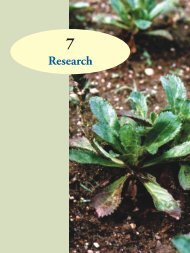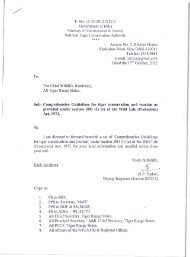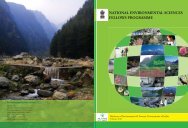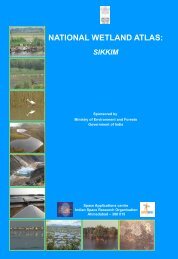rainforest restoration - Ministry of Environment and Forests
rainforest restoration - Ministry of Environment and Forests
rainforest restoration - Ministry of Environment and Forests
You also want an ePaper? Increase the reach of your titles
YUMPU automatically turns print PDFs into web optimized ePapers that Google loves.
ainforest <strong>restoration</strong> in the western ghats: an overview21An ancient hill range, running along the west coast <strong>of</strong> Indiafor 1,600 kilometres from the southern tip <strong>of</strong> the IndianPeninsula to the River Tapti in the North, the Western Ghatsis a global biodiversity hotspot along with Sri Lanka.The Western Ghats has a tropical climate thatshows pronounced variation along north–south, east–west, <strong>and</strong> altitudinal gradients. In general, the vegetationbecomes drier as one progresses from west to east (rainshadow) across the hills, more seasonal as one goes fromsouth to north, <strong>and</strong> cooler <strong>and</strong> wetter as one ascendsthe hills. Thus, an impressive range <strong>of</strong> natural vegetationtypes is found in the Western Ghats from tropical dry thorn<strong>and</strong> deciduous forests to moist deciduous forests, semievergreen,<strong>and</strong> wet evergreen forests in progressivelywetter areas. There are also unique types such as theMyristica swamps, the bamboo <strong>and</strong> cane brakes, <strong>and</strong> themontane grassl<strong>and</strong>s <strong>and</strong> shola forests.In the southern Western Ghats, the Anamalai hillsregion is particularly special as it contains the entire range<strong>of</strong> natural vegetation types that one may encounter in thesouthern Western Ghats from dry thorn to shola forest,<strong>and</strong> reed brakes to grassl<strong>and</strong>s. The tropical wet evergreenforests <strong>of</strong> the Western Ghats, are broadly classified intolow- (mostly below < 700 m), medium- (700–1,400 m), <strong>and</strong>high-elevation (>1,400 m) types. In planning ecological<strong>restoration</strong>, it is important to identify the correct type<strong>of</strong> natural vegetation in the region <strong>and</strong> know theircharacteristic plant <strong>and</strong> animal species.Tropical <strong>rainforest</strong>s <strong>of</strong> the Western GhatsAmong these vegetation types, the wet evergreen forestsor <strong>rainforest</strong>s are special. These <strong>rainforest</strong>s occur all alongGhats from Maharashtra to Kerala. Some <strong>of</strong> the best tractsare found in the southern Western Ghats, the region south <strong>of</strong>the Palghat gap (a 40 km-wide break in the mountain range)that contains some <strong>of</strong> the highest peaks <strong>and</strong> vast stretches<strong>of</strong> mature evergreen forests. These forests also containmuch <strong>of</strong> the plant <strong>and</strong> animal diversity, particularly endemicspecies (species not found anywhere else in the world).Left: An Elaeocarpus serratus tree towers into the canopy <strong>of</strong> a <strong>rainforest</strong> in southern India | Kalyan VarmaAbove: The plants <strong>of</strong> the <strong>rainforest</strong> are exquisitely adapted in morphology <strong>and</strong> ecology to life in the tropical environment




